|
 Austropaxillus macnabbii Austropaxillus macnabbii
SynonymsPaxillus aurantiacus
Paxillus macnabbii
Austropaxillus aurantiacus
Austropaxillus macnabbii
Images (click to enlarge)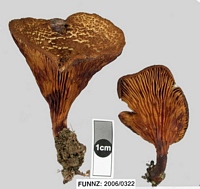
Caption: Col. DA0479, FUNNZ: 2006/0322, See public note for more information
Owner: FUNNZ | 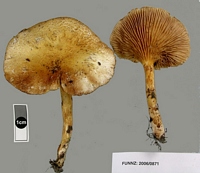
Caption: Col. DA0485, FUNNZ: 2006/0871, See public note for more information
Owner: FUNNZ | 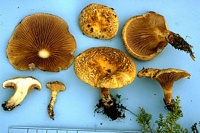
Owner: Karl Soop | 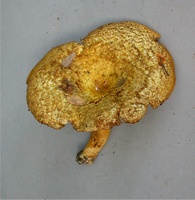
Owner: P. Leonard | 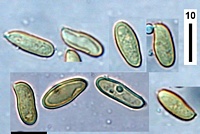
Caption: spores
Owner: J.A. Cooper | 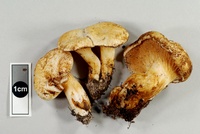
Owner: J.A. Cooper | 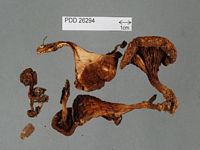
Caption: Dried type specimen
Owner: 26294 | 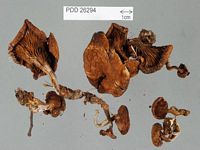
Caption: Dried type specimen
Owner: Herb PDD | 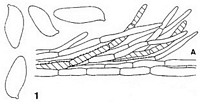
Caption: McNabb (ZT 68/275). spores, cuticle. | 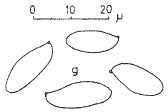
Caption: P. aurantiacus: spores. | 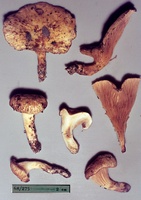
Caption: ZT68-275
Owner: E. Horak: © Creative Commons Attribution-Noncommercial 3.0 New Zealand | 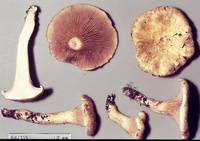
Caption: ZT68-355
Owner: E. Horak: © Creative Commons Attribution-Noncommercial 3.0 New Zealand | 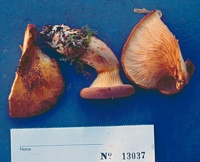
Owner: Ron Petersen |
Article: McNabb, R.F.R. (1969). The Paxillaceae of New Zealand. New Zealand Journal of Botany 7(4): 349-362 (http://www.rsnz.org/publish/abstracts.php).
Description: PILEUS: convex when young, becoming centrally depressed, infundibuliform, or
irregularly infundibuliform at maturity, 3-8.5 cm diam., dry, tomentose, felted,
velutinate, or finely squamulose, often circumferentially creviced and exposing
the white context or centrally squarrose at maturity, white with yellow tints
when young, yellowish orange, yellowish brown, yellow, or golden yellow at maturity,
squamules when present darker brown; cuticle a poorly organised trichodermium when young, at maturity composed of repent or obliquely ascending
filamentous hyphae with simple septa and yellowish brown contents, terminal
cells cylindrical or tapering apically, thin-walled or slightly thick-walled,
often externally roughened, 7-12.5 µm. diam.; margins strongly to moderately
involute when young, often undulate and irregularly lobed at maturity. LAMELLAE:
moderately crowded, deeply decurrent, repeatedly dichotomously branched 4-(5)
times, not anastomosing or meruloid near stipe, 2-4 mm deep, dull creamy yellow
when young, golden yellow at maturity, paling near margins of pileus, unchanging
where damaged, lamellulae absent. STIPE: 1.5-4 cm long, tapering basally, 0.5-1
cm diam, apically, 0.5-0.75 cm diam. basally, central or occasionally eccentric,
solid or slightly hollowed at maturity, dry, finely velutinate-subtomentose
near apex by presence of short, septate, filamentous hyphae 4-7.5 µm. diam.
with yellowish brown contents, otherwise subglabrous, yellowish white when young,
often with yellowish brown stains, more or less concolorous with pileus at maturity;
flesh white to sordid brownish white, unchanging on exposure to air; basal mycelium
white; veil absent.
SPORES: spore print orange-brown (Amber Brown); spores golden melleous to bright
rusty brown, broadly elliptic-subfusiform, suprahilar depression or applanation
typically present, apiculate, germ pore absent, 11.5-14-(15.5) X 4.8-6 µm, moderately
thick-walled, smooth. HYMENIUM: basidia hyaline, sub-clavate to clavate, 42-58
X 7.5-10 µm, 4-spored; cystidia absent but paraphysis like structures of irregular
diam. present, occasionally clavate structures with mucronate apices present
but not projecting beyond basidia. HYMENOPHORAL TRAMA: bilateral, mediostratum
of moderately loosely interwoven, longitudinal hyphae, lateral stratum of closely
interwoven hyphae; clamp connections absent. CONTEXT OF PILEUS: white, yellowish
around larvae tunnels, unchanging on exposure to air. SMELL: not distinctive.
TASTE: bitter. CHEMICAL CHARACTERS: KOH on pileus— reddish brown; on context—yellow;
NH4OH on pileus—orange-brown or reddish brown with a reddish or pinkish orange
flush; on context—no reaction or faintly yellow.
Habitat: HABITAT: Gregarious or caespitose under Nothofagus.
Notes:
Paxillus aurantiacus belongs in sect. Defibulati and is closely related
to P. squarrosus. It differs in the yellow pileus, structure of the cuticle,
white unchanging context, presence of sterile structures in the hymenium, and
the finely velutinate to subglabrous stipe. The unchanging context, repeatedly
dichotomously branched lamellae, and differences in chemical characters distinguish
it from the South American P. statuum.
Singer (1962) indicated that if the Australian
species P. muelleri (Berk.) Sacc. lacked clamp connections, it also should
be included in sect. Defibulati. Subsequent examination of authentic
material by Pegler (1965) showed that clamp connections were absent in this
species, and the section now contains four species endemic to the South Temperate
Zone.
Article: Horak, E. (1980) [1979]. Paxilloid Agaricales in Australasia. Sydowia 32: 154-166.
Article: Singer, R.; García, J.; Gómez, L.D. (1990). The Boletineae of Mexico and Central America I & II. Beihefte zur Nova Hedwigia 98: 70 p.
Description: *See Horak (1979, 1983) and McNabb (1969). His P. aurantiacus is a homonym (Paxillus
aurantiacus Ellis) and should be known as P. mcnabbii nom. nov. (= P. aurantiacus
McNabb, N. Zeal. Journ. Bot. 7: 357. 1969, non Ellis).
Article: Pennycook, S.R. (2003). Nomenclatural revisions of New Zealand agarics and boletes. New Zealand Journal of Botany 41(3): 501-502 (http://www.rsnz.org/publish/abstracts.php).
Description: Recently, Bresinsky & Jarosch (Bresinsky et al.1999) created a new bolete genus
Austropaxillus to accommodate Southern Hemisphere species of Paxillus, including three New
Zealand endemic species described by McNabb (1969). One of McNabb's names, Paxillus
aurantiacus, is an illegitimate later homonym; consequently, Bresinsky & Jarosch's binomial
Austropaxillus aurantiacus must be treated as a nomen novum dating from 1999 rather than a
combinatio nova based on a 1969 basionym (Greuter et al. 2000, Article 58). Thus, the nomen
novum Paxillus macnabbii previously published by Singer et al. (1990) has priority, and it is
here recombined in Austropaxillus.
Austropaxillus macnabbii (Singer, J.García & L.D.Gómez) Pennycook,
comb. nov.ç
Paxillus aurantiacus McNabb, N.Z. J. Bot. 7, 357 (1969), nom. illegit., non Ellis 1882. ç
Paxillus macnabbii Singer, J.García & L.D.Gómez, Beih. Nova Hedwigia 98, 4 (1990), nom.
nov., as "mcnabbii".ç Austropaxillus aurantiacus Bresinsky & Jarosch, in Bresinsky et al.,
Plant Biology 1, 332 (1999), nom. nov. superfl., as "comb. nov."
NOTES: Index of Fungi 6: 442, 1994, is mistaken in attributing the misspelt epithet
"auranticus" to McNabb (1969); the origin of this misspelling is a typographic error in Index
of Fungi 3: 561, 1970.
|